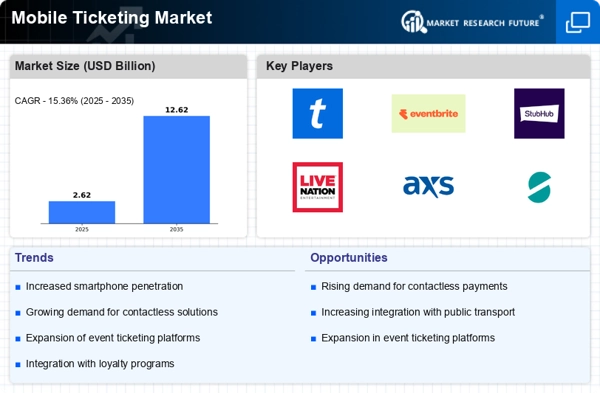Enhanced User Experience
The Mobile Ticketing Market is significantly influenced by the demand for enhanced user experiences. Consumers increasingly seek convenience and efficiency in their transactions. Mobile ticketing solutions offer features such as instant access to tickets, real-time updates, and easy sharing options. This focus on user experience is reflected in the growing number of mobile ticketing transactions, which are projected to reach over 10 billion by 2026. The ability to bypass traditional ticketing methods, such as physical tickets and long queues, appeals to a tech-savvy audience. As a result, businesses in the Mobile Ticketing Market are likely to invest in user-friendly interfaces and innovative functionalities to attract and retain customers.
Rising Smartphone Penetration
The increasing penetration of smartphones is a pivotal driver for the Mobile Ticketing Market. As more individuals acquire smartphones, the accessibility of mobile ticketing solutions expands. In 2025, it is estimated that smartphone users will surpass 6 billion worldwide, facilitating the adoption of mobile ticketing applications. This trend indicates a shift in consumer behavior, where users prefer the convenience of purchasing and storing tickets on their devices. The Mobile Ticketing Market benefits from this trend, as it aligns with the growing demand for seamless and efficient ticketing experiences. Furthermore, the integration of advanced features such as QR codes and digital wallets enhances user engagement, potentially leading to increased sales and customer loyalty.
Growing Popularity of Live Events
The growing popularity of live events is a significant driver for the Mobile Ticketing Market. As more consumers seek experiences over material goods, the demand for tickets to concerts, sports events, and festivals continues to rise. In 2025, the live events sector is expected to generate revenues exceeding 30 billion, with a substantial portion attributed to mobile ticketing solutions. This trend indicates a shift in consumer spending habits, where individuals prioritize experiences that can be easily accessed through mobile devices. The Mobile Ticketing Market stands to benefit from this trend, as event organizers increasingly adopt mobile ticketing platforms to streamline sales and enhance customer engagement.
Increased Focus on Sustainability
The increased focus on sustainability is emerging as a vital driver for the Mobile Ticketing Market. As environmental concerns gain prominence, consumers are more inclined to choose eco-friendly options. Mobile ticketing eliminates the need for physical tickets, thereby reducing paper waste and contributing to sustainable practices. In 2025, it is estimated that the demand for sustainable solutions in ticketing will grow by 20%, reflecting a broader societal shift towards environmental responsibility. The Mobile Ticketing Market is likely to capitalize on this trend by promoting the environmental benefits of digital tickets. This alignment with sustainability not only attracts eco-conscious consumers but also enhances brand reputation for businesses within the industry.
Integration of Advanced Technologies
The integration of advanced technologies is a crucial driver for the Mobile Ticketing Market. Innovations such as artificial intelligence, machine learning, and blockchain are transforming how tickets are sold and managed. For instance, AI can personalize ticket recommendations based on user preferences, while blockchain technology enhances security and transparency in transactions. The Mobile Ticketing Market is witnessing a surge in the adoption of these technologies, with a projected market growth rate of 15% annually through 2027. This technological evolution not only streamlines operations but also builds consumer trust, as users feel more secure in their transactions. Consequently, businesses that leverage these technologies are likely to gain a competitive edge.

















Leave a Comment